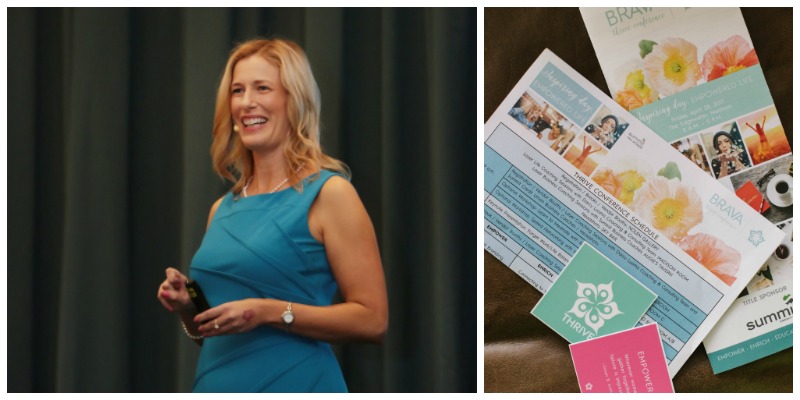It truly was an inspiring day for an empowered life
BRAVA’s second annual THRIVE Conference was a sold-out success, offering over 250 attendees 12 workshop offerings and a keynote morning speech by noted UW Health psychologist Shilagh Mirgain.
Mirgain’s keynote was titled “Forget Work/Life Balance— Find Flow.” She led the speech by noting that she’d recently googled “work/life balance” and her search yielded 21 million hits. She wasn’t surprised by the bounty of blogs and podcasts.
They’re artifacts of a culture taken to kneeling at the cape hem of the mythical Superwoman (that is, when we actually have a moment to genuflect to her between the dings of our push notification reminders and spooling to-do lists). As women, she noted, the Myth of Superwoman tells us that we can and should do it all— in our careers, our communities and in our domestic “second shifts”— and that in order to do this really well, we ought to make a quest for the work/life balance holy grail.
Mirgain knows a secret, however. “Balance” means something different from moment to moment in a woman’s life. Balance can be elusive. Therefore, striving for a work/life balance solution cannot, in fact, be the true path to happiness or consistent wellbeing. Instead, Mirgain invited us to pivot from these paths of unsustainable balance in order to embrace flow.
Flow, Mirgain reflected, is natural to us. It’s the pull of the moon. It’s ocean tides, the change of seasons, the way of rivers and our birthright. As a process, flow happens when we’re so immersed in our pursuits, we’re completely absorbed by them— and in a good way! In flow, one works hard— yet the work feels effortless. Mirgain earnestly studied flow as an attainable skill set and observed how flow functions in the lives of performance athletes, creatives, and masters of mindfulness.
Here are just a few of the many lessons she offered:
- A key component of flow is intention. We are present, immersed and focused in flow. Without focus, there’s no flow. Cultivate your present focus instead of forever thinking about what’s next.
- Flow happens at different speeds. Consider your past week. How did you flow and stay present (or not) as you encountered daily life?
- “Yes, and” is a highly effective approach to life and work. When you encounter twists and turns, try to think “yes, and” instead of “no”. You’ll be equipped, then, to flow with the current instead of paddling against it.
- Allow for the “flex” of flow in your workday through creation of boundaries. Are there ways you can toggle your work? Chunk your work time on the calendar? Employ what’s known as “The Pomodoro Technique,” allowing 15 minutes to move into focus, 25 minutes of work time and short breaks? Save email for the office?
- Build a fortress against interruption. Take special care to avoid self-interruptions, such as with electronics.
- —Plug into your own personal “power source”. If you can access your source of power, you can maintain work momentum.
- Realize and highlight your signature strengths. Honestly assess yourself; what gives you energy and what drains you.
- Practice the art/science of centering the body. Focus on your breathing. Employ the SOAR technique during stressful times: Stop, Open up, attain Awareness and then Respond from a deeper, more grounded place.
- Cultivate purposeful positivity. Self-generate through such practices as gratitude, humor and savoring. Find positive connections with others.
- In all of these ways, you can be the flow, go with the flow, accept that there will be debris along the course. Ask yourself, honestly and often, “How can I take my own potential more seriously?”
After Mirgain’s keynote, attendees broke up into the day’s 12 workshop opportunities, organized along the themes Empower, Enrich, Educate and Entrepreneur. Here’s a sampling of some of the workshops.
Personal Branding for Professional Growth with Ellen Bartkowiak
- When crafting a personal branding statement, consider: What do you do? Who you do it for? How are you unique?
- Expand to consider questions such as: What makes you special or interesting? What qualities would you use to describe yourself? What are some examples from your business or personal life that illustrate those qualities? What events have shaped or changed your life? What obstacles have you overcome? Have you taken risks? Gotten lucky?
- Combine the above to create a powerful personal branding statement that’s uniquely yours and yours alone.
- Create a personal brand profile by first plotting your thoughts around areas such as: Your mission, vision, needs, values, interests and passions; Your strengths, personal descriptors (your “unique factor”), your promise of value, your target audience and more.
Confident Communications: Creating a Positive & Effective Workplace with Susan Young
- Great workplace communication is a skill of mutual respect. Cultivate that respect by considering your workplace’s energy dynamics. You want to be fully engaged and positive for maximum performance and full engagement— invigorated, confident, challenged, joyful and connected.
- Utilize the wealth of available personality inventory tools to better understand both yourself and others in your workplace.
- Ignite emotional intelligence! Check your self-awareness, self-regulation skills, motivation, empathy and social skills. Consider your body language as well as the way you connect with your team. Build trust and rapport, be friendly, be curious and seek to learn from one another. Use fun and humor. Celebrate differences and express your appreciation for your colleagues.
- Study and utilize the appropriate “love languages” when creating a culture of appreciation that is truly expressed and received. Ways people show appreciation include words of affirmation, quality time, receiving gifts, acts of service and physical touch. Resource: “The 5 Languages of Appreciation in the Workplace” by Dr. Gary Chapman & Dr. Paul White.
Design the Life You Want to Live by Ann Garvin
- What is work for you (not what you do but why you do it)? What do you think about the world and how do you think the world works? In order to design the life you want to live, connect the dots between powerful questions of who you are, what you do, what you believe and where your ideas work in harmony, clash and enhance one another?
- What would you do if money were a non-issue? Take out the money and status (ego) for a moment and take a very close look at what’s meaningful to you. You will see many possibilities open up through this exercise. Make it an ongoing one.
- Harness the power of asking questions of yourself. What is something you’re willing to release? Conquer? You can’t have a problem you aren’t willing to have. What is your passion? What forward moving action are you willing to commit to for today?
- When considering a potential future, ask yourself what the best possible outcome would be for you? Consider your core values here. Again, remove your ego or any need for accolades and just consider, for a long moment, what your best outcome would be. Pieces of your life design puzzle will reveal themselves through exercises such as these.
- Think about what you need/want. Then study what comes up for you. Then move forward in action. Think- Study – Do. This builds momentum along a customized, self-actualized path.





Comments are closed.